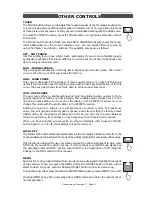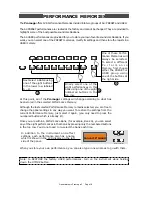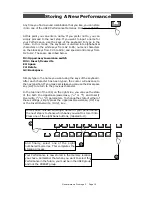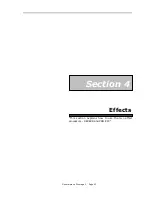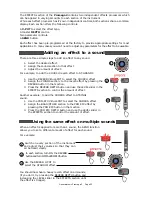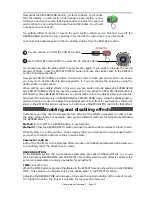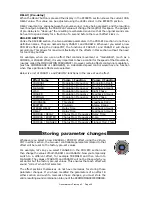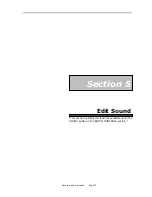
Generalmusic Promega 2 Page11
Example 5: Simple sound editing
J
J
J
Sometimes you may want to make a sound a little brighter or darker to make it more or
less prominent in the mix. The EDIT SOUND function contains a simple little filter which
allows you to adjust the brilliance of any section.
While playing chords below the split, press the OCTAVE
+ key in the VINTAGE KEYS section. You will hear the
pitch of the sound raise by one octave. Press this key
a second time to place the sound in a more playable
range.
Turn off the VINTAGE KEYS section and select the sound
SLOWSTRING PAD in the BASS/OTHER section
Press the SOUND button in the EDIT & CONTROLS section.
The EDIT & CONTROLS display now shows FLT indicating that you
are ready to adjust the filter setting for each section. The individual
displays of each section are now showing you their current filter
setting, (normally these will be at zero).
Lets make the string sound on the left side a little darker and the
piano sound on the right side a little brighter. Moving the slider
upwards will increase the brilliance while moving it downwards will
decrease it. When the slider is in the central position the sound is
restored to its normal setting of zero.
Move the slider in the BASS/OTHER section downwards to
select a value of about 30. You can hear this change in real
time while you are playing the sound.
Move the slider of the PIANOS section, upwards to select a
value of about 30.
Edit functions such as SOUND, MIDI and CONTROL, (CONTR.) contain
a number of different functions under one button. You can switch
between these various functions using the PAGE UP/PAGE DOWN
keys underneath the EDIT & CONTROLS display. Lets use the next
function of EDIT SOUND.
Press the PAGE UP button, (>)
The EDIT & CONTROLS display now shows PAN indicating that you
are ready to adjust the pan position, (or stereo balance), for each
section.
The individual displays of each section are now showing
you their current pan position, (normally these will be at zero
meaning that the sound is sent equally to the left and right channel).
Lets send the string sound slightly more to the left channel and the piano sound slightly more to
the right channel.
NOTE: The
instrument must
be amplified in
stereo to hear
this effect.
Move the slider in the BASS/OTHER section downwards to select a value of about 30
You should hear the sound move slightly towards the left channel.
Move the slider of the PIANOS section, upwards to select a value of about 30.
You should hear the sound move slightly towards the right channel.
J
J




















